Continued from the previous page.
UPPER ATRIUM GALLERY
In two of the photos farther below you can see the walkway on the second
floor that is open on all four sides around the atrium. The displays
rotate in this gallery.
Today I was most fascinated by the exhibit about climbing North
America's tallest peak, Mt. McKinley AKA Denali ("The High One"):
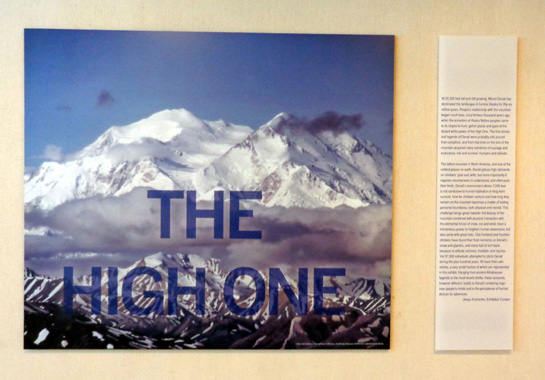
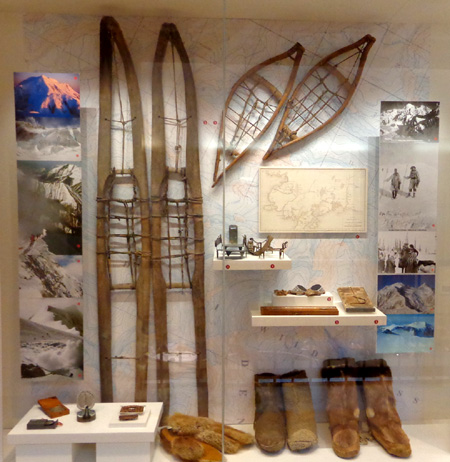
Some old climbing equipment
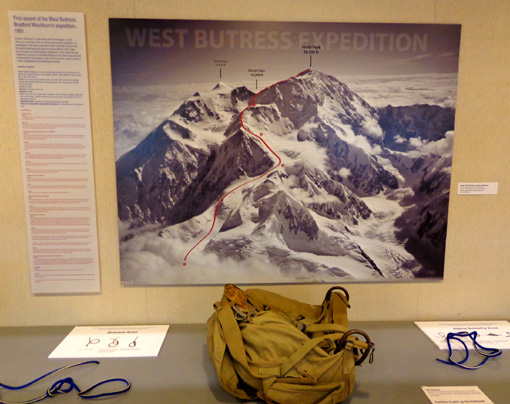
The most popular of several routes up Denali
According to the exhibit's curator, over 37,000 people have attempted to
climb Denali in the last century. Fewer than half of them reached the
summit and/or returned safely and 114 died in the attempt. I don't know it that
includes the six people who died on the mountain this spring.
Climbing Denali is something I might have been able to do before I got
osteoarthritis in my late 40s.
I know better than to try it now in my
60s but it's fun to learn more about what it takes to summit The High
One. On our way to Denali National Park we plan to stop at the ranger
station in Talkeetna, where climbers must go through an orientation
program before beginning their
climbs. During the summer rangers give talks to visitors about the
history of climbing the famous peak.
THIRD & FOURTH LEVELS
I didn't have time to see either of the two upper floors today. Both are
in the new wing and smaller than the main and second floors.
The third floor houses rotating art, history, and science exhibits. The
fourth floor is home to the
Chugach Gallery,
which also has temporary exhibits
and panoramic views of the Chugach Mountains and downtown Anchorage from
large windows.
MAIN LEVEL: THE ATRIUM
After spending almost two hours exploring the exhibits on the second
floor I walked down to the
ground floor of the museum via the
grand staircase in the atrium:
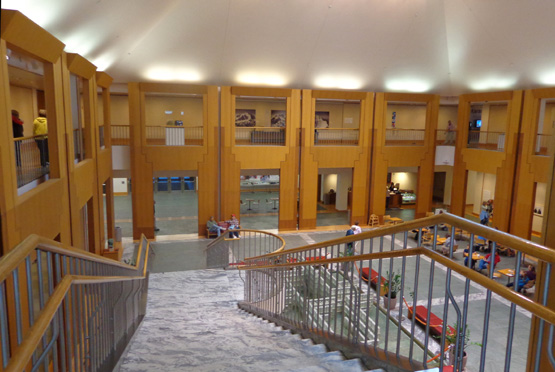
You can also use elevators to reach each floor.
The atrium features an attractive marble floor, handsome wood paneling,
the Muse
restaurant/café, other seating, a
large glass block art feature, and a totem pole:
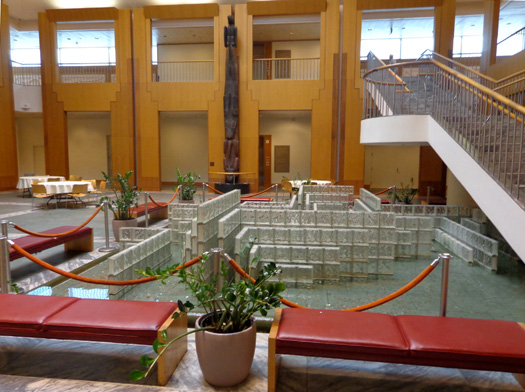
Below is a Tlingit Indian totem pole carved from red cedar in the
mid-1800s. It came from Prince of Wales Island in Alaska.
You can see in the picture above that it the totem is about two stories
tall. It used to be even
taller but the bear figure that was originally at the bottom rotted off.
This is what's left:
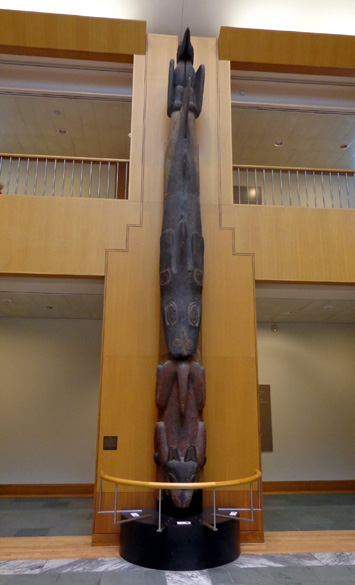
The figures represented on the remaining totem are (top to bottom) a
raven, shark, and either a fox or wolf.
This pole has been exhibited around the country at several world's fairs
since 1904. I think it's in remarkable condition considering the age of
the wood and all the cross-continental travel.
ART OF THE NORTH GALLERIES
Also on the ground
floor are seven art galleries devoted to the museum's permanent Art of the
North collection.
Displays include large-scale landscape paintings,
drawings and engravings from early European expeditions to Alaska, and works by
contemporary Alaska artists.
Here are a couple
pieces I really liked, both representing Alaska's fishing
industry:
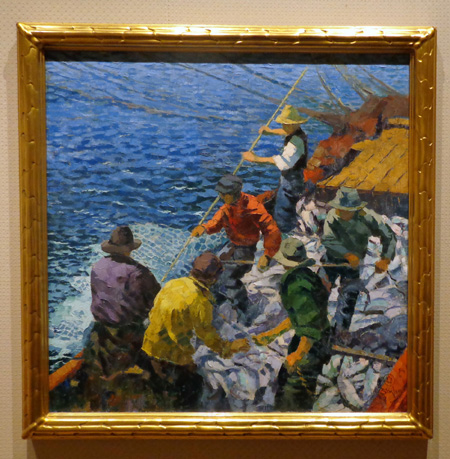
"Alaska Fishermen" by Eustace Ziegler, oil on
canvas, c. 1930
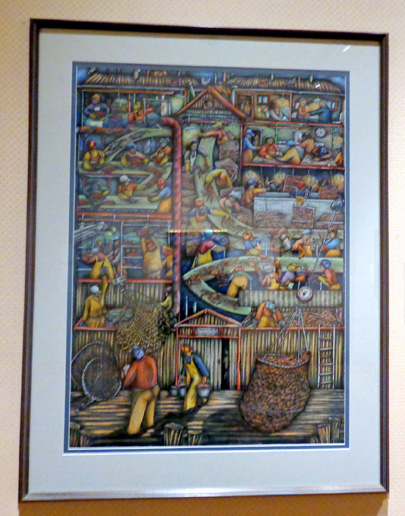
"Cannery Life" by Carolyn Reed, charcoal and
colored pencil, 1991
One of the seven galleries is
devoted to the work of Sydney Laurence, Alaska's best-known landscape
artist.
This is part of the large room showcasing some of his beautiful
pieces:
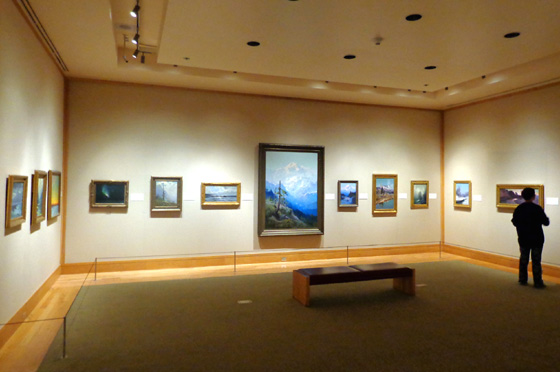
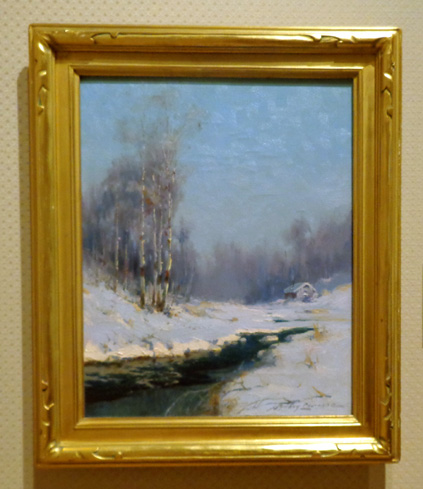
"Creek In Birch Forest" by Sydney Laurence, oil on
canvas
Trained as an artist
but obviously an adventurer at heart, Laurence was drawn to Alaska in
1904 by the lure of gold.
Although his efforts
at mining and oil leases weren't particularly lucrative, he did become a
very successful painter. He opened a studio in Los Angeles, lived there
and in Seattle during the winter, and spent every summer sketching and
painting landscapes in Alaska.
Laurence's favorite
subject to paint was Mt. McKinley AKA Denali. Since I'm fascinated with that
magnificent mountain I was instantly
drawn to his beautiful renderings of it. Just look at the
grand scale of the next picture of Denali, measuring about 4 feet high by 8 feet wide:
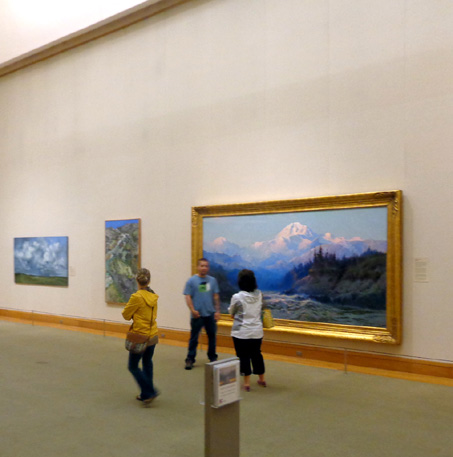
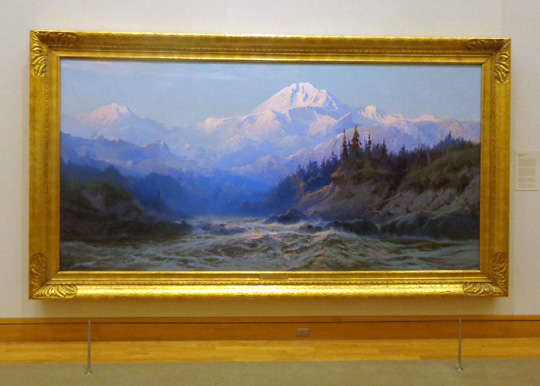
"Mt. McKinley" by Sydney Laurence, oil on canvas,
1929
The other works by Laurence displayed in this gallery are smaller and I
could imagine them gracing my own home . . . (as if).
ALSO ON THE MAIN LEVEL: THE IMAGINARIUM
The recent renovation allowed the museum to completely revamp and expand its
educational programs and experiential learning facilities.
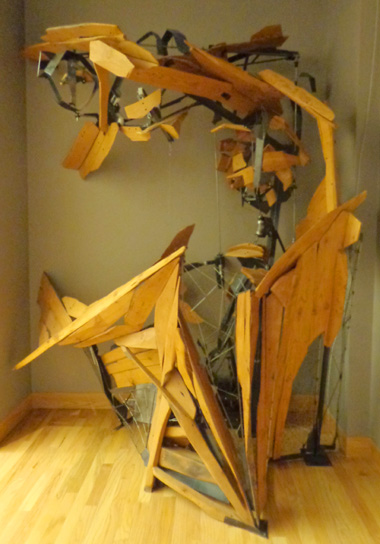
Art-from-science: a sculpture by Ben Trautman
called "Rolling Plates"
at the entrance to the Imaginarium; it
depicts the often-violent
natural forces of volcanoes, ice, water, etc. that
shape the land in Alaska.
Both kids and adults can have a lot of fun at the new Imaginarium
Discovery Center, a hand's-on science discovery center with 80+ exhibits
on the first floor.
Interactive displays encompass a wide range of scientific studies from
geology to astronomy.
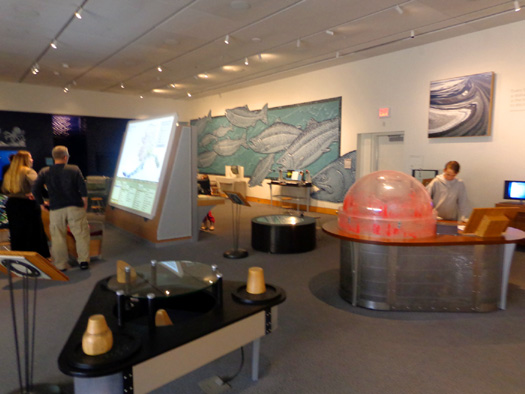
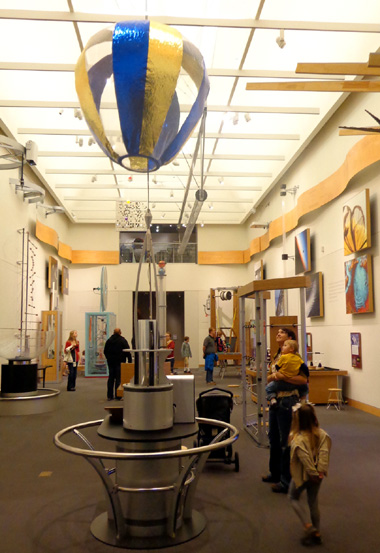
This is another place where I wished I'd had more time to browse.
There is also a planetarium with entertaining films and presentations
-- another thing I didn't have time for today.
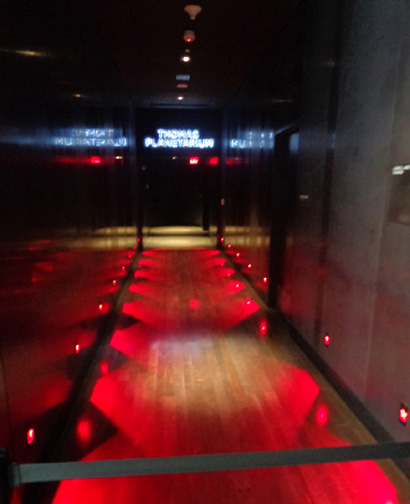
Entrance to the Thomas Planetarium
I obviously need to pay another (longer) visit to this museum!
That's it for the Anchorage Museum. For more
information, check out the museum's
website.
MORE ART IN THE DOWNTOWN AREA: THE WHALING WALL
I learn some interesting things when I do additional
research for entries on this website. Here's an example.
You've heard of the "Wailing Wall," right?
I couldn't remember its history so I looked it up.
The ancient Wailing Wall, also known as
the Western Wall, is located in Old Jerusalem. It's either the first or
second most holy place for people of the Jewish faith. Since about the
4th Century thousands of Jews have made annual pilgrimages to pray at
the wall. In more modern times, tourists of every faith have gone
there to pray while visiting the city.
The site is not without controversy, however.
For just about as long as this section of wall has stood in ruin, there
has been conflict between Jews and Muslims over its origin. Muslims
claim the wall was part of a mosque, not an ancient Jewish temple.
Control of Jerusalem has passed through many different hands for 3,500+
years. Because the city -- and the wall -- are now
controlled by Israel, the Wailing Wall remains one of many sources of
bitterness between Israel and the Arab world.
You can read more about the history and significance of the wall at
this site or others you can find during an
internet search.
Wikipedia also has quite a lot of
information and photos.
So what's this got to do with Anchorage?
Some folks might find this terribly sacrilegious . . . but there is a
Whaling Wall in Anchorage. I read about it in some of the tourist
information we've picked up and we drove past it today:
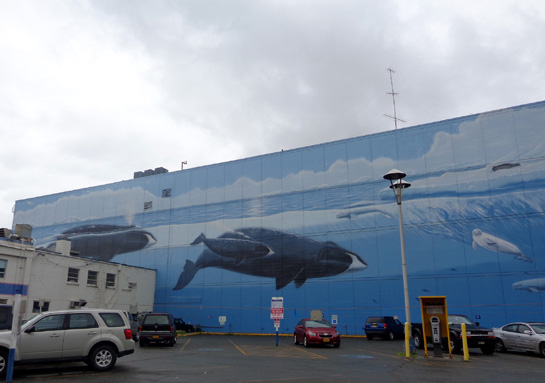
It's a very large (400 feet long, 50 feet high) mural of whales painted
on one side of the J.C. Penney store in downtown Anchorage.
The subject, whaling, is very pertinent to Alaska. The name "Whaling
Wall" would be
the only source of contention, I'd think. (We think it's clever, not
sacrilegious.)
What I discovered during an internet search is that this is #54 in a
series of 100 other similar large "Whaling Wall" murals painted by
marine artist
Wyland (he goes by that single name).
The title of the one in Anchorage is "Alaska's Marine Life." It was
painted in 1994.
You can see a list of the other 99 whale murals Wyland has created
around the world at this
link. Quite a few of them are in U.S. states on the east and
west coasts and even some inland states. Others can be found all over
the globe -- Canada, Mexico, Brazil, France, Britain, China,
Japan, Guam, Palau, American Somoa, Australia, and New Zealand.
It is estimated that Wyland's murals of life-size whales are viewed by a
billion people every year. I also learned that his art and his
non-profit foundation have had an enormous impact on environmental
issues around the world.
Guess I've been living under a rock because I don't remember hearing
about him before.
I think it would be interesting to see as many of these murals as possible
in our travels around the USA and Canada. Unfortunately, the list of the sites indicates at least 21 of the murals
are no longer accessible for various reasons (covered, destroyed, or
significantly altered). That's a shame.
THE REST OF OUR DAY
On the way home to the Black Spruce Campground this afternoon we ran some more errands, then discussed our travel
plans in more detail.
In the evening
Jim watched a couple DVDs about
military planes. He gets free videos and movies from the library on base
-- a good alternative to Netflix or Red Box when feasible.
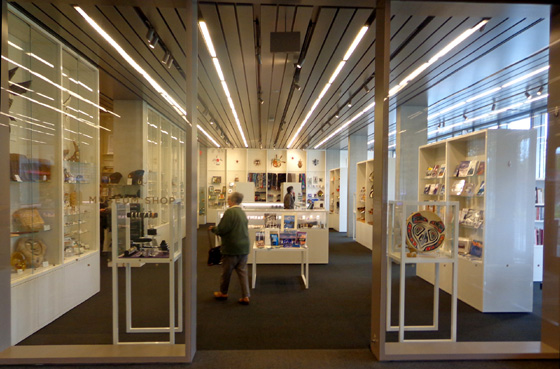
The Museum Store on the main level of the Anchorage
Museum has books, Native Alaskan art,
hand-made jewelry, and other things for sale.
You can get in there without paying admission. <wink>
I took Cody for a walk in and near our campground. after supper.
Neither Jim nor I have seen any bears or moose in the campground or on
base since we’ve been here this time. We saw several of each near our
campsite back in
June.
The hosts told Jim that one day
recently four RVers said they’d seen a bear near their campers so we
know they're still around. We just have to be at the right place at
the right time to see them.
Next entry: the Iditarod Sled Dog Museum and Mat-Su
Visitor Center
Happy trails,
Sue
"Runtrails & Company" - Sue Norwood, Jim O'Neil,
and Cody the ultra Lab
Previous
Next
© 2012 Sue Norwood and Jim O'Neil